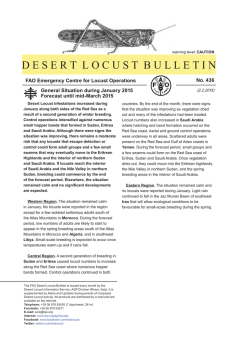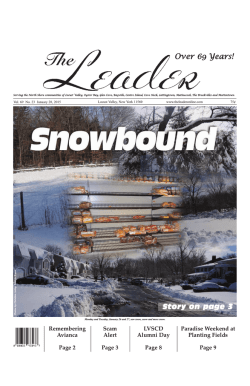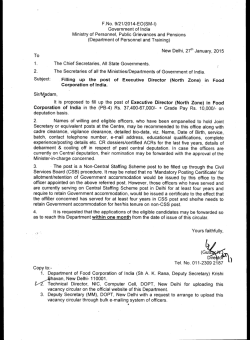
FAO Desert Locust Information Service (DLIS) helps countries to
FCC-EMPRES Information Sheets 1 DLIS features ACTING AS A FOCAL POINT AND COORDINATOR OF A GLOBAL LOCUST INFORMATION NETWORK MONITORING WEATHER, ECOLOGICAL CONDITIONS AND LOCUST INFESTATIONS IN AFRICA, NEAR EAST AND ASIA ON 24/7 BASIS USING GIS TO ANALYSE THE CURRENT LOCUST CONDITION IN EACH COUNTRY The Desert Locust (Schistocerca gregaria) is considered the most dangerous of all migratory pest species in the world. It threatens people’s livelihoods, food security, the environment and economic development. It can easily affect more than 65 of the world’s poorest countries. It can reproduce rapidly, migrate long distances and devastate crops and pasture. The Desert Locust has the ability to change its behaviour and appearance, under particular environmental conditions (unusually heavy rains), and transform itself from a harmless individual to part of a collective mass of insects that form a swarm, which can cross continents and seas, and quickly destroy a farmer’s field and his entire livelihood in a single morning. A Desert Locust adult can consume roughly its own weight in fresh food per day that is about two grams every day. A 1 km² size swarm contains about 40 million locusts, which eat the same amount of food in one day as about 35,000 people, 20 camels or 6 elephants. During quiet periods (known as recessions), solitarious locusts are found in low numbers scattered throughout the deserts of North Africa, the Middle East and Southwest Asia. This arid area is some 16 million km² in size, and includes about 30 countries. It is called the recession area. During a plague, swarms can also invade other countries and a greater amount of land equivalent to about 20% of Earth’s land can be affected (invasion area). DLIS: from map reading to GPS The first records of Desert Locust plagues date from Pharonic Egypt and have been documented throughout history. During the first 60 years in the 20th century, there were five major plagues, lasting up to 14 years. Since 1963, there has been a dramatic decline in the frequency and duration of plagues, and now plagues occur perhaps only once every 10 to 15 years and rarely last more than three years. Today, locust-affected countries’ ability to detect, respond to and contain Desert Locust outbreaks has improved as a result of advances in technologies related to geo-positioning, spatial analysis, remote sensing and early warning. Food Chain Crisis | Emergency Prevention System © FAO © Field Sudan FAO Desert Locust Information Service (DLIS) Helps countries to control Desert Locust The reduction in the frequency, severity and duration of Desert Locust plagues and their associated food losses has been possible thanks to the adoption of a preventive control strategy relying on early warning and early reaction by locust-affected countries and FAO. FCC-EMPRES FCC-EMPRES Information Sheet FAO Desert Locust Information Service (DLIS) Helps countries to control Desert Locust › DLIS features Producing information on a daily basis for about 30 countries in the affected region Working with national locust information officers Producing monthly situation bulletins and six-week forecasts for each country Sending warnings and alerts about potential invasions FAO Desert Locust Information Service FAO Desert Locust Information Service (FAO DLIS) is the key monitoring and early warning tool in preventing Desert Locust plagues from devastating farmers’ fields in Africa and Asia. Since 1978, FAO DLIS operates an early warning system that monitors weather, ecological conditions, and locust infestations in the potentially affected area on a daily basis. After 75 years of systematic Desert Locust monitoring and collaboration between locust-affected countries and DLIS, today’s FAO DLIS has revolutionized the process. In the past three decades, the system has shifted from camels to four-wheel drive vehicles, from telex to email, from map reading to GPS, from narratives to handheld data loggers, from manual plotting to GIS, and from weather station reports to satellite-based rainfall estimates and greenness maps. GPS, RAMSES (Reconnaissance and Management System of the Environment of Schistocerca) and SWARMS (Schistocerca Warning and Management System) GIS, the Internet and eLocust3 (Android-based tablet) have replaced the traditional tools of paper, coloured pencils, maps and telephone. People at the centre of DLIS FAO/DLIS E-mail: [email protected] Web site: www.fao.org/ag/locusts Twitter: Twitter@faolocust DLIS manages an internet-based group of some 25 national locust information officers, a simple mechanism to keep national officers in contact with each other and share information every day. The primary and most important source of information are survey and control © FAO, 2015 Food Chain Crisis | Emergency Prevention System © FAO 1 reports from affected countries. Each key country has a Locust Information Officer who is responsible for collating, analysing and transmitting this data to DLIS by email. DLIS, in turn, analyses the data and keeps countries informed of the current situation and expected developments. DLIS issues a monthly bulletin in three languages (English, French and Arabic) to locust-affected countries, the international donor community, researchers, institutes, and other interested parties that summarizes the current situation and provides a six-week forecast on a per-country basis. During periods of increased locust activity, the bulletins are supplemented by updates, warnings and alerts. DLIS spends considerable efforts to strengthen the capacities of nationallydesignated locust information officers. New tools are developed to facilitate the collection, transmission, management and analysis of data. Annual workshops are held for English and French speaking information officers as a forum for informal discussions on the use, problem-solving and improvement of various tools (eLocust3, eLocust2Mapper, RAMSES, remote sensing, social media) used by the officers. This global early warning system, based on new advances in technologies, can be a model for other migratory pest early warning systems throughout the world. I4353E FCC-EMPRES
© Copyright 2026




